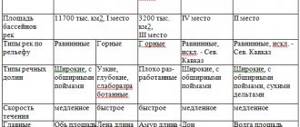Chemical industry of Russia (grade 9)
Summary of an open lesson on geography
Teacher:
Ibragimov Abdul Emiraslanovich
Class
: 9th grade
Lesson topic
: Chemical industry of Russia
The purpose of the lesson
: study the location features, composition of the chemical industry. Main problems and prospects of the industry.
Tasks
:
- educational
: consider the features of the Russian chemical industry; show its importance in the Russian economy; reveal the features of the location of the chemical industry;
- developing
: continue to develop the skills to analyze, identify cause-and-effect relationships, work with statistical material, independently find material on the topic and format it competently; fill out the table “Chemical industry”; find industries, products, centers, factors for the location of the chemical industry;
- educational
: responsible attitude towards fulfilling the assigned task.
Lesson type
: combined.
Method of implementation
: explanation, independent work, advance
Requirements according to the program
:
- have
an idea of the characteristics of the chemical industry;
- know
: the main areas of location of the chemical industry, factors for the location of main production facilities, the role and importance of the industry.
- be able to
: independently work with the text of the textbook and with the map.
Equipment:
statistical materials (tables, diagrams), presentation “Chemical industry of Russia”, multimedia equipment, workbooks, test materials, map of the chemical industry of Russia; atlas maps, PC, multimedia projector.
During the classes
1.Organizing time
.
- Greetings;
- Preparing the audience for work;
- Availability of students.
2.Motivation for educational activities.
Message of the topic, purpose of the lesson. Use in further activities.
Knowledge about the characteristics of the chemical industry allows us to better understand the processes taking place today.
Plan
1. History of the development of the industry.
2.Himiko – forest complex. Features of the chemical industry.
3. Types of industries, products, location factors and centers of the chemical industry.
4. Main bases of the chemical industry.
3.Homework message.
&28 – 29, pp. 143 – 150.
Leading task
Prepare a report on industrial forests in Russia.
4. Consolidation of the studied material.
Practice questions and assignments to reinforce the topic. (Individual assignments, work with statistical materials)
5. Summing up the lessons.
1.Assess the degree of implementation of the goals set during the lesson.
2.Evaluate the work of students during classes.
- Learning new material.
1. History of the development of the industry (slide No. 3, 4).
The chemical-forest complex consists of two large industries - chemical and forestry. What unites these industries into one complex is that they both use natural (mineral and plant) raw materials.
The leading role is played by the chemical industry, which is a vanguard industry along with energy and mechanical engineering, as it determines the development of the scientific and technological revolution through the chemicalization of the economy.
Chemical industry is a branch of industry that includes the production of products from hydrocarbon, mineral and other raw materials through their chemical processing.
The chemical industry became a separate industry with the beginning of the industrial revolution. The first plants for the production of sulfuric acid, the most important mineral acid used by humans, were built in 1740 (Great Britain, Richmond), in 1766 (France, Rouen), in 1805 (Russia, Moscow region), in 1810 (Germany, Leipzig). To meet the needs of the developing textile and glass industries, the production of soda ash arose. The first soda factories appeared in 1793 (France, Paris), in 1823 (Great Britain, Liverpool), in 1843 (Germany, Schönebeck an der Elbe), in 1864 (Russia, Barnaul). With the development in the middle of the 19th century. In agriculture, artificial fertilizer factories appeared: in 1842 in Great Britain, in 1867 in Germany, in 1892 in Russia. Raw materials connections and the early emergence of industry contributed to the emergence of Great Britain as a world leader in chemical production during three quarters of the 19th century. Since the end of the 19th century. With the growing demand of economies for organic substances, Germany is becoming a leader in the chemical industry. Thanks to the rapid process of concentration of production, a high level of scientific and technological development, and an active trade policy, Germany by the beginning of the 20th century. conquers the world market for chemical products. In the United States, the chemical industry began to develop later than in Europe, but by 1913 the United States took and has since held 1st place in the world among states in terms of chemical production. This is facilitated by the richest reserves of minerals, a developed transport network, and a powerful domestic market. Only by the end of the 80s did the chemical industry of the EU countries in general terms exceed production volumes in the United States.
2.Himiko – forest complex. Features of the chemical industry (slide No. 5).
The chemical-forest complex consists of two large industries - chemical and forestry. What unites these industries into one complex is that they both use natural (mineral and plant) raw materials.
The leading role is played by the chemical industry, which is a vanguard industry along with energy and mechanical engineering, as it determines the development of the scientific and technological revolution through the chemicalization of the economy.
The gross output of the chemical industry in the world is about 2 trillion. dollars. The volume of industrial production of the chemical and petrochemical industry in Russia in 2008 amounted to 528,156 million rubles.
Task No. 1 (slide No. 6, 7):
-The chemical industry differs from other industries in a number of features. Working independently with the text of the textbook: identify three features of the chemical industry.
3. Types of industries, products, location factors and centers of the chemical industry.
Task No. 2 (slide No. 8, 9):
-Working with the text of the textbook and the map of the atlas “Chemical Industry”, fill out the table “Chemical Industry”.
Task No. 3 (slide No. 10,11):
Mark on the contour map the main bases of the Russian chemical industry.
Consolidation of the studied material (slide No. 12).
Additional Information
Sub-sectors of the chemical industry
| Sub-sector | Examples |
| Inorganic chemistry | Ammonia production, Soda production, Sulfuric acid production |
| Organic chemistry | Acrylonitrile, Phenol, Ethylene Oxide, Urea |
| Ceramics | Silicate production |
| Petrochemistry | Benzene, Ethylene, Styrene |
| Agrochemistry | Fertilizers, Pesticides, Insecticides, Herbicides |
| Polymers | Polyethylene, Bakelite, Polyester |
| Elastomers | Rubber, Neoprene, Polyurethanes |
| Explosives | Nitroglycerin, Ammonium Nitrate, Nitrocellulose |
| Pharmaceutical chemistry | Medicines: Synthomycin, Taurine, Ranitidine... |
| Perfumes and cosmetics | Coumarin, Vanillin, Camphor |
The largest chemical companies in Russia
| Company, headquarters | Sales volume in 2007, million rubles. | Specialization | Place |
| Sibur Holding, Moscow, | 142.7 billion rubles in 2007 | Petrochemistry | 1 |
| Salavatnefteorgsintez, Salavat, Bashkortostan | 63 997,8 | Petrochemistry | 2 |
| Eurochem, Moscow | 53 490,3 | Fertilizer production | 3 |
| Nizhnekamskneftekhim, Nizhnekamsk, Tatarstan | 48 069 | Synthetic rubbers | 4 |
| Akron Veliky Novgorod | 23 547,3 | Mineral fertilizers | 5 |
| Uralkali, | 20 721,2 | Potash fertilizers | 6 |
Information sources
1. Rom V.Ya., Dronov V.P. Geography of Russia. Population and economy. - M.: Bustard, 2007.
2. Zhizhina E.A. Lesson developments in geography. Population and economy of Russia. - M.: VAKO, 2007.
3.Sirotin V.I. Independent and practical work in geography (grades 6-10). – M.: Education, 2006.



